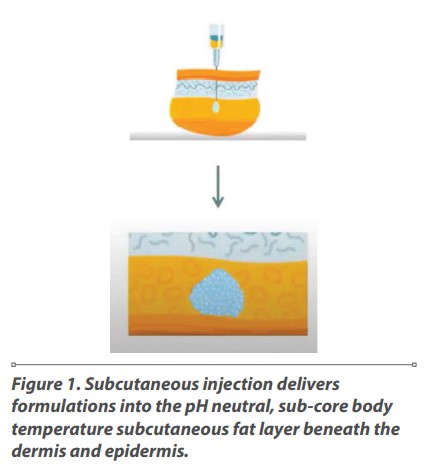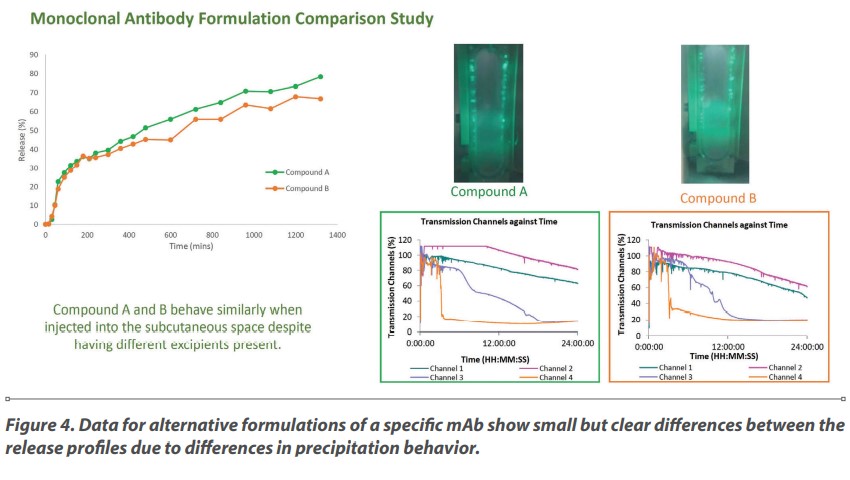Imogen Anastasiou, Market Manager –Biopharmaceutical Pion, Inc
Subcutaneous injection is a routine method for administering drugs, notably for biopharmaceuticals. However, it is challenging to predict how Active Pharmaceutical Ingredients (APIs) such as Monoclonal Antibodies (mAbs), peptides and hormones will be impacted by the injection process and entry into the subcutaneous layer. The application of shear stress during the injection process, changes in temperature and pressure, and chemical stresses such as changes in buffer composition and pH all have the potential to trigger aggregation and precipitation of the API.
Such effects can lead to poor in vivo release characteristics, compromising bioavailability and clinical efficacy and in the worst case, safety. Successful drug development calls for robust assessment of the fate of a drug from its introduction to the patient through absorption and metabolism to excretion. For ethical and financial reasons, there is a preference to minimize in vivo investigations to elucidate such behavior, but for subcutaneously administered drugs there is the added complication that correlations between animal models and human outcomes tend to be particularly poor. In vitro tools for biorelevant investigations are therefore highly desirable.
This article introduces the Subcutaneous Injections Site Simulator (SCISSOR) a first-in-class instrument that simulates the stress and environmental transitions associated with subcutaneous injection. By reliably monitoring the impact of changes in temperature, pH and other aspects of the chemical environment the SCISSOR system allows formulators to replace in vivo tests of questionable value with in vitro strategies with stronger predictive power. Experimental data highlight the application and value of this innovative technology.
The Process of Subcutaneous Injection
Closer examination of the process of subcutaneous injection helps to explain why biorelevant testing is a significant challenge when it comes to studying the behavior of the associated drug formulations.
Biologics and other drugs for administration by subcutaneous injection are typically formulated under acidic conditions using a citrate or phosphate buffer, and stored at low temperature to extend shelf-life. These conditions change rapidly and significantly upon injection into the subcutaneous fat layer that lies beneath the dermis and epidermis of the skin.
Firstly, the formulation is subject to shear stress as pressure is applied to push the dose through a fine bore needle into the subcutaneous layer. In vivo the active then transitions from the controlled, acidic conditions within the vial or prefilled syringe to the close to neutral pH (~7.4) of the subcutaneous space. Here there is potential for the API to interact with other components of the extracellular matrix, such as hyaluronic acid, collagen, fibronectin, chondroitin sulfate, and temperature increases to about 34°C. The subcutaneous layer is cooler than core body temperature, but markedly warmer than the conditions typically applied during storage to maximize drug stability.

Because biological APIs are inherently labile, these stresses and environmental transitions introduce the risk of conformational change, aggregation between API molecules or API and excipient(s), and precipitation. Excipient aggregation can also be an issue with small molecule drugs. These processes can directly influence therapeutic efficacy and increase the risk of an immune response upon injection. In addition, larger aggregates are more susceptible to being engulfed by macrophages prior to entering the blood or lymphatic vessels, an effect that can cause bioavailability to plummet.
Such interactions are impossible to see in in vivo models designed to focus on drug uptake. Though such models elucidate the fate of the drug they provide little understanding of the associated reasons for success or failure, about what happens to the API immediately after it transitions into the subcutaneous space. This explains why correlation between animal models and human outcomes is notoriously poor for drugs administered via subcutaneous injection. In vitro studies are preferrable but rely on having a biorelevant system that can representatively simulate the physiological conditions associated with this specific drug delivery process.
Introducing SCISSOR, a New Tool for Simulating Subcutaneous Injection
Figure 2 shows a schematic of the Sc chamber highlighting key design features. At the heart of the instrument is a cartridge filled with an artificial extracellular matrix (ECM) that simulates the subcutaneous space. On two parallel sides of the cartridge lie customized polycarbonate dialysis membranes while the other two sides are clear to enable light transmission for turbidity measurement. The cartridge is suspended inside a chamber filled with a bicarbonate-based buffer to simulate the interstitial fluid.
Formulated drug samples are injected directly into the cartridge and subsequently diffuse away from the injection site through the dialysis membranes into the chamber buffer. Extracting aliquots of the buffer at various time points allows the user to quantify drug release from the cartridge as a function of time via offline analysis. Configuration with automated sampling is useful for assays conducted over an extended timeframe, and more generally to increase productivity. Alternatively, real-time monitoring can be implemented using a device such as the Rainbow fiber optic dip probe to measure drug release in situ and generate data quickly and easily in real time.

Electrodes in the cartridge and within the chamber allow the constant pH monitoring needed to maintain the system at physiologically relevant conditions; a CO2 bubbler is used to adjust pH as necessary. A heating plate enables temperature regulation to maintain the 34°C required, while a stirrer bar ensures system homogeneity. Two chamber volumes are available: 300mL for relatively concentrated formulations products, in the range of ~100–200mg/mL and a smaller 60 ml chamber for more dilute formulations, of about 10mg/mL or less, depending on sample characteristics. At low concentrations dilution by diffusion into a large chamber can compromise robust analysis.
Precipitation and aggregation events within the cartridge are detected by turbidity measurement using an LED display and corresponding diode detection set-up. When the contents of the cartridge are completely clear, 100% light transmission occurs. Conversely, a completely opaque suspension reduces transmission to 0%. Measuring turbidity at different heights inside the cartridge, throughout the experiment, therefore provides an assessment of drug stability upon and after injection. These turbidity sensors are complemented by an integral camera that captures images enabling the direct visualization of any aggregates or precipitates.
SCISSOR in Action: MAbs
MAbs are one of the most popular classes of biopharmaceutical drugs and primary candidates for subcutaneous drug delivery. Early studies carried out by a team at the University of Bath show the effectiveness of the SCISSOR device for predicting the bioavailability of different mAbs1 (see Figure 3). These results indicate that % bioavailability (%BA) values generated for eight different mAbs are much closer to comparable data from in vivo human studies than in vivo data from two model species, monkeys or minipigs.
Figure 4 shows further data generated for mAbs, this time to compare the delivery profile of two slightly different formulations of the same drug molecule. Such comparisons of alternative compounds are an important application for SCISSOR, which can be used to support formulation towards specific delivery characteristics.
The results show that over the course of 24 hours post-injection the release profiles of the two formulations are somewhat similar. For the first six hours or so, the release curves are almost identical but over time small differences in precipitation behavior emerge that cause a shift in the release profile. These differences can be observed in turbidity data and images of the samples (see Figure 4). The ability to generate this type of information is helpful when determining which might be the best formulation to choose for further development.

Figure 5 shows data from a further study of a different mAb that provides additional evidence of the value of being able to study precipitation behavior directly, following drug injection. This formulation resulted in zero drug release over a 24-hour period though the reasons for this were unclear. Pairing transmission and photographic data provides insight into what happens to this sample after injection and a rationale for the zero-release behavior. At initial injection, the formulation is fairly transparent, but after around three minutes, photograph G onwards, the sample starts to become opalescent. The corresponding decrease in transmission is particularly marked in Channels 3 and 4 indicating that precipitation occurs predominantly towards the bottom of the cartridge. These data suggest that precipitation was the reason why none of the API was released from the cartridge into the chamber.
SCISSOR in Action: Away from Antibodies
While antibodies typically rely on subcutaneous injection for delivery, they are far from the only drug modality to be administered in this way. The following examples provide snapshots of SCISSOR in action with a range of different types of drug molecule. As an example of a non-proteinaceous large molecule, the polysaccharide anticoagulant enoxaparin, a form of heparin, was studied.
Figure 6 shows SCISSOR data for a commercial enoxaparin formulation. There is no evidence of precipitation – transmission remains close to 100% throughout - and the results indicate that the drug starts to leave the injection site about an hour after injection. Though correlation with in vivo performance is difficult to establish (due to the availability and variability of published data) the drug release profile is consistent with reports of maximal therapeutic activity about five to six hours after injection.

Figure 7 further illustrates the potential of SCISSOR as a tool for formulation studies, this time for screening excipients. An important role of excipients is to tailor delivery profiles, with ingredients used to alter a formulation’s viscosity, pH, or theoretical charge at pH 7.4 to control release profile. In this study PEG, Mannitol, NaCl and NaOH were added to a commercial formulation of hydrocortisone sodium succinate, a small molecule drug, to assess their impact on the drug release profile. The results show that adding PEG and mannitol (Formulation 1) dramatically speeds up API release while adding sodium chloride and sodium hydroxide slows it down again. This is valuable information for formulation optimization.


Figure 8 shows data contrasting the performance of rapid and delayed release of insulin formulations to provide a final illustration of the utility of SCISSOR. The rapid insulin formulation is a clear solution as evidenced from high transmission, with a relatively rapid onset time and fast release profile. In contrast, the basal formulation is designed to release the hormone in a slow and steady fashion. The drug release profile suggests that it is successful in this regard with transmission data corresponding with extended solubilization of the microcrystalline suspension over the six hours of the study.
Looking Ahead
In vitro tools that elucidate the impact of subcutaneous injection on APIs have an important role to play in enhancing our ability to use this important drug delivery route reliably and successfully. Minimizing in vivo testing is important from both an ethical and financial perspective but with subcutaneous injection correlations between animal models and the behavior of drugs in humans are notoriously unreliable.
This article introduces new technology, the SCISSOR platform, that can be used for in vitro study of the impact of injection. Suitable for a wide range of APIs including mAbs, small molecules, peptides, gels, and even solid implants such as polymeric rods, SCISSOR provides insight that is simply inaccessible via in vivo testing and has demonstrated capability for the prediction of %BA and drug release profile. Experimental data demonstrate the broad application and value of SCISSOR in formulation studies to assess biopharmaceutical consistency immediately after injection, to detect how changing excipients alters delivery profiles and to representatively rank potential formulations. These are important gains with respect to accelerating the development of new drug formulations for subcutaneous injection.
References
- Bown H.K et al ‘In vitro model for predicting bioavailability of subcutaneously injected monoclonal antibodies’ Journal of Controlled Release 273 (2018) 13 - 20
Subscribe to our e-Newsletters
Stay up to date with the latest news, articles, and events. Plus, get special
offers from American Pharmaceutical Review delivered to your inbox!
Sign up now!